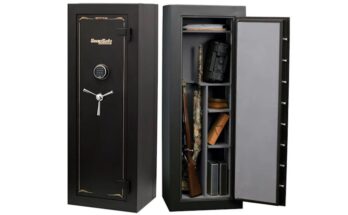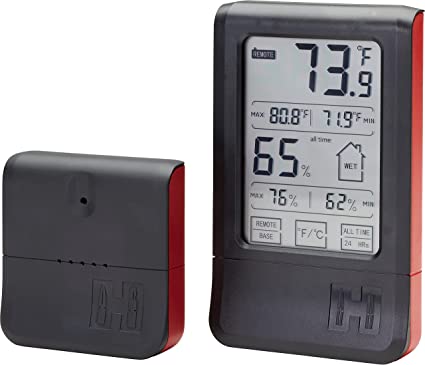Sweat can indeed cause a gun to rust. The salt and moisture in sweat can corrode metal parts.
Understanding how to maintain your firearm is crucial for both safety and longevity. Sweat, containing salt and other corrosive elements, poses a significant threat to the integrity of a gun’s metal components. As a gun owner, knowing the risks of corrosion and taking preventative measures are part of responsible ownership.
Regular cleaning and proper storage are essential in preventing the damaging effects of sweat on firearms. By keeping your gun dry and well-lubricated, you can ensure that it remains in top working condition. This attention to care not only preserves the function of your firearm but also maintains its value over time.

Credit: www.amazon.com
Sweat And Guns: An Unexpected Combo
Many people never think about sweat and guns together. Yet, these two can meet. Especially when you carry a gun close to your body. Sweat might just cause issues you never expected. Let’s dive into why this happens and how to prevent it.
The Chemistry Of Sweat
Sweat isn’t just water. It’s full of salts and minerals. When you sweat on your gun, these left-behinds can lead to trouble. Why? Because the salts in sweat can react with the metal parts of your gun.
- pH levels: Your skin’s sweat is usually slightly acidic.
- Electrolytes: They are more than in sports drinks. They’re in your sweat, too! Electrolytes can conduct electricity, which speeds up corrosion.
- Salt: When you hear salt and metal, think rust. They don’t mix well.
Metal’s Natural Enemy: Corrosion
Corrosion is a metal’s biggest battle. It’s a fight that metal often loses. When sweat meets a gun, it can start this battle. Guns are made of metal, and metal rusts.
| Factor | Effect on Guns |
|---|---|
| Moisture | Creates ideal conditions for rust. |
| Salts in Sweat | Act as catalysts, speeding up the rusting process. |
| Oxygen in Air | React with metal, causing oxidation. |
Remember, small amounts of sweat can cause big damage over time. Regular cleaning is key to protecting your gun from sweat-induced corrosion. Keep your firearms dry, clean, and well-oiled, and they’ll serve you well for years to come.

Credit: issuu.com
The Rusting Process Explained
The Rusting Process Explained opens an intriguing chapter in the care and maintenance of firearms. Often, gun owners overlook the potential damage that one’s own sweat can cause to their weapon. Understanding how rust forms is vital, particularly when handling objects as sensitive as guns.
Iron Oxidation: A Primer
Rust is the common name for iron oxide, which occurs when iron, or its alloys, are exposed to oxygen and moisture over a period of time. Here’s a simple breakdown of the process:
- Iron (in the gun metal) combines with oxygen (in the air).
- Moisture, such as water or humidity, serves as a catalyst.
- Oxidation results in reddish-brown deposits known as rust.
Sweat’s Role In Accelerating Rust
Human sweat can be a notorious contributor to the rusting process. Sweat is salty and acidic which makes it a perfect storm for rust. Let’s look at how sweat interacts with your gun:
- Sweat from hands or body transfers to the gun surface.
- The salt and acids in sweat act like a catalyst, speeding up oxidation.
- With time, if not cleaned, sweat can lead to significant rust damage.
Cleaning guns regularly and keeping them dry is essential. Proper storage and maintenance ensure the longevity of firearms. Remember, a little sweat might seem harmless, but when it comes to guns, it’s a surefire way to rust.
Rust’s Impact On Firearms
The silent enemy of any firearm is rust. Rust can stem from various factors, including the minute droplets of sweat that slip from a person’s hands onto their gun. Over time, this seemingly innocuous moisture can lead to a host of problems that undermine the integrity and functionality of a firearm.
Reduced Reliability And Safety
When a gun rusts, its reliability takes a nosedive. The precision-engineered parts are no longer smooth and efficient. Instead, they become compromised by pitting and corrosion.
- Jamming becomes more frequent.
- Firing mechanisms can misfire or fail to fire.
- Internal rust may not be visible without a detailed inspection.
This not only affects the performance but also increases the risk to the user and those around them.
Aesthetic And Functional Degradation
Rust does not just stop at internal mechanisms. It can wreak havoc on the exterior as well.
- Exterior rust: Erodes the metal and weakens the gun structure.
- Barrel integrity: Gets compromised, affecting accuracy and safety.
- Surface blemishes: Decrease the firearm’s value, both monetary and sentimental.
Preserving a gun’s appearance is crucial for collectors and enthusiasts alike. Once the surface is damaged, extensive refurbishing is often required to restore its former glory.
Protective Measures Against Sweat Corrosion
Keeping your gun in top condition demands action against sweat corrosion. Sweat contains salts and acids. These elements cause rust. Rust damages guns. To preserve your gun, take protective measures. The right care extends your firearm’s life and keeps it ready for use.
Regular Cleaning And Maintenance
Clean your gun often. Every use follows with clean up. Here are key steps:
- Disassemble based on the manufacturer’s guide.
- Wipe all parts with a clean cloth.
- Apply gun oil to protect from moisture.
- Check for signs of wear or damage.
Perform a deep clean periodically.
- Use solvents for bore cleaning.
- Brush the barrel with a bore brush.
- Lubricate moving parts lightly.
- Reassemble and function check.
Using Protective Coatings And Materials
Coatings and materials act as a barrier against sweat. Look into these options:
| Coating Type | Benefits |
|---|---|
| Protects against corrosion; improves appearance | |
| Offers durable protection; ideal for military firearms | |
| Resists corrosion, scratches; comes in various colors |
Additional materials to consider:
- Grip sleeves to absorb hand moisture
- Gun socks when not in use
- Silica gel packs in your gun safe for humidity control
Match the right material with your gun type and usage. Protective gear ensures longevity and reliability.
Sweat-proofing Your Firearm For The Long Haul
Sweat can indeed rust a gun, but there’s good news: preparation and protection can keep your firearm in tip-top shape for years to come. This section focuses on creating a sweat-proof regimen to maintain your gun’s longevity. Let’s dive into the best practices for storage and explore advanced technologies in firearm preservation.
Best Practices For Storage
Proper storage is critical for keeping moisture, including sweat, at bay.
- Use a Dehumidifier: Place this device in your safe to control humidity.
- Regular Cleaning: Always clean guns after use before storage.
- Silica Gel Packs: Include these in your storage area to absorb moisture.
- Avoid Soft Cases: These can trap moisture; opt for hard cases with padding.
| Storage Condition | Recommendation |
|---|---|
| Humidity Level | Keep below 50% for best results |
| Temperature | Stable, cool temperatures are ideal |
Advanced Technologies In Firearm Preservation
Invest in technologies designed to extend your firearm’s life, even in harsh conditions.
- Corrosion Inhibitors: These compounds create a protective barrier on the metal.
- Biometric Safe Access: Regulate who has access to your firearm, reducing handling and potential sweat exposure.
- Rust-Resistant Finishes: Opt for guns with coatings that repel moisture.
- Desiccant Air Systems: For larger collections, invest in a system that continually controls the air quality around your firearms.
Regular maintenance paired with the right technology can shield your guns from sweat-induced rust. Stay vigilant with these strategies, and enjoy a pristine, fully-functioning firearm collection for the long haul.

Credit: usasafeandvault.com
Real-life Scenarios Of Sweat And Gun Corrosion
Exploring the impact of sweat on firearms isn’t just theoretical. Countless weapons have suffered under the corrosive touch of human perspiration. In this section, we uncover real situations where moisture from the body has led to the deterioration of guns, arming you with knowledge to prevent similar issues.
Historical Instances
History is riddled with tales of valor, but few consider the silent enemy that faced many warriors: corrosion from sweat.
- Soldiers in tropical climates often found their rifles quickly rusting.
- The salty sea air mixed with sweat proved detrimental to naval cannons.
- Historical artifacts, like swords and firearms, show signs of pitting from handling and storage without care.
These events highlight the crucial need for regular maintenance to combat sweat-induced rust.
Modern-day Occurrences And Lessons Learned
Even today, gun owners witness the battle between metal and moisture. The stories teach us valuable care strategies.
| Scenario | Outcome | Lesson |
|---|---|---|
| Policemen with holstered sidearms | Varying degrees of rust and wear | Implement regular gun cleaning |
| Concealed carry firearms in humid conditions | Increased risk of corrosion | Use moisture-wicking fabrics and corrosion inhibitors |
| Hunters in different weather conditions | Surface rust on exposed metal parts | Apply protective oils; store in a dry environment |
Proper care and storage emerge as constants in the fight against gun corrosion. Awareness and adherence to maintenance can mean the difference between preservation and ruin of these essential tools.
Frequently Asked Questions For Can Sweat Rust A Gun?
Can Human Sweat Cause Gun Corrosion?
Yes, human sweat can cause gun corrosion. Sweat contains salts and acids that are corrosive. When it comes into contact with metal, it can initiate rust, especially in humid conditions. Regular cleaning is key to prevention.
How Quickly Can Sweat Rust A Firearm?
Sweat can begin to rust a firearm within a few hours. The speed depends on the moisture, firearm material, and protective coatings. It’s crucial to wipe down guns after handling to avoid rust buildup.
What Parts Of A Gun Are Most Vulnerable To Sweat?
The most vulnerable parts of a gun to sweat are the metal components without protective coatings. This typically includes areas frequently touched by hands, like the trigger, hammer, and barrel. Use oil and handle with gloves when possible.
Is Gun Rust From Sweat Dangerous?
Gun rust from sweat can be dangerous. Rust compromises the firearm’s integrity and can lead to malfunctions. It is important to maintain guns properly to ensure safety and reliability.
Conclusion
Care for your firearms is paramount to longevity and reliability. Sweat can indeed cause rust on guns without proper maintenance. Regular cleaning and storage in a cool, dry place can prevent corrosion. Protecting your investment from the corrosive effects of perspiration ensures performance and safety for years to come.
Keep your gun rust-free; keep it sweat-free.



